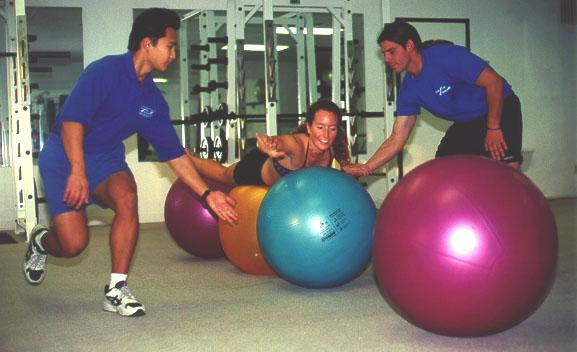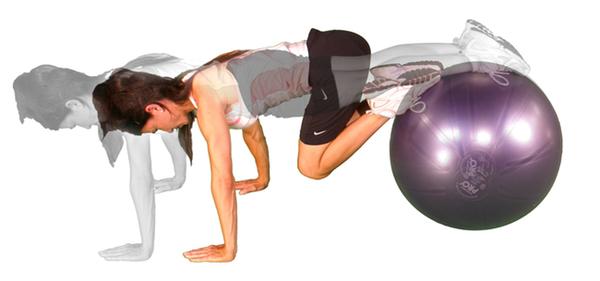Swiss Ball Training For Swimmers
by Paul Chek

Spring is here and summer isn’t far off. So, NOW is a great time to get ready for one of everyone’s favorite warm weather sports: Swimming.
Like most sports, swimming requires a great deal of core strength to achieve optimal results. Since all movements emanate from the core, it’s critical to build a strong base of support for the prime movers so they can function properly.
An excellent training tool to strengthen your core is the Swiss ball, because it challenges your nervous system, builds up your stabilizer strength and adds variety to your workout.
The core conditioning exercises I’ll discuss here are specifically designed for swimmers and have a high carryover to the sport.
Behind the scenes
The prime movers of a swimmer’s upper body are the latissimus dorsi (lats) and pectoralis major, along with the subscapularis, teres major and triceps. For kicking, the prime movers are the hip flexors and quadriceps.
Most of a swimmer’s power comes from the latissimus dorsi and hip flexors. These muscles originate in the back and/or the pelvis. If the origin of a muscle isn’t stable, less than optimal power will be generated. Also, if your pelvis is unstable, you will not be able to generate maximum power with each kick and stroke and your times will increase.

Note: A = hamstring/gluteus maximus, B = lumbar erectors and latissimus dorsi, C = iliposoas, D = rectus femoris (C & D hip flexors) E = abdominal muscles. The arrows above indicate corresponding lines of pull on the pelvis. The dotted arrow indicates the depression of the pelvis in water due to lack of pelvic stabilization. Horizontal dark arrows indicate the counter-balancing action of the abdominals. The vertical arrow indicates lift action on the pelvis created by the abdominals during counter-balancing functioning.
In swimming, since neither leg is stabilized, the abdominals, particularly the muscles called the obliques, take over the role of primary stabilizers.
When the abdominal muscles are not strong enough to balance the forces created by the hip flexors and lats, the pelvis tilts forward, causing increased drag. To prevent hinging of the torso and improve ability to plane, it is essential to condition the core correctly. By improving core strength, drag will be reduced.
Improved core strength will also aid in trunk rotation, another key element of swimming. Trunk rotation is important in reducing surface area and decreasing the load on the shoulders.
Swiss ball exercises
To improve your performance in the pool, include these four Swiss Ball exercises in your current training program by either:
- Doing two exercises to fatigue one time each, four days a week.
- Performing multiple sets of one exercise, after each swimming session.
If you are a distance swimmer you will want to have short rest periods (under 1 minute). For sprinters, you will want to have longer rest periods (3-4 minutes) and work at a high intensity.
For all of these exercises, be sure to place your tongue on the roof of your mouth to properly activate the neck stabilizer muscles.
Arch to bridge
With your feet on a Swiss Ball, get into a push-up position. Slowly drop down as you arch your back, then draw your belly button inward and slowly return to the start position and hold it for three seconds, making sure to keep your head and back in neutral alignment.
 Bridge
Bridge
Hold the same push-up position as in the arch to bridge exercise, but you can spread your feet out a bit for more support. Raise one arm out in front and slowly move it around your side as if you were outlining a half-circle.
Keep your head and back straight, do not go into flexion, let your pelvis drop down or raise or drop your head.
 Supine wheelbarrow
Supine wheelbarrow
Have a partner hold your feet level with the top of the Swiss ball, or secure them on a bench or against a wall. Lie back over the ball, keeping your head in alignment with your spine.
While holding this position, begin doing a freestyle stroke. To increase its difficulty, roll back so you increase the distance between your head and the ball.
 Swiss ball swimmer level 1
Swiss ball swimmer level 1
Position yourself as you were for the supine wheelbarrow, but, this time, place your feet on the floor. You will now need to focus on keeping your pelvis up, so that your spine stays in a neutral alignment.
Perform any stroke you wish as you hold the starting position. Increase the difficulty of this exercise by adding a kicking motion with one leg. Performing this exercise on a padded mat or on grass is recommended in case you fall off the ball. If you are sweaty or wet, place a towel over the ball to prevent slipping.
 Whether you’re a serious competitor or a recreational swimmer, these exercises will get you ready for the water. Enjoy!
Whether you’re a serious competitor or a recreational swimmer, these exercises will get you ready for the water. Enjoy!
Love and chi,
Paul


